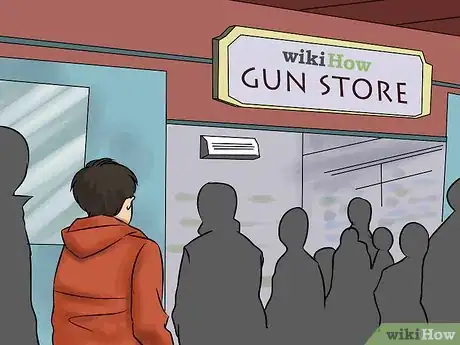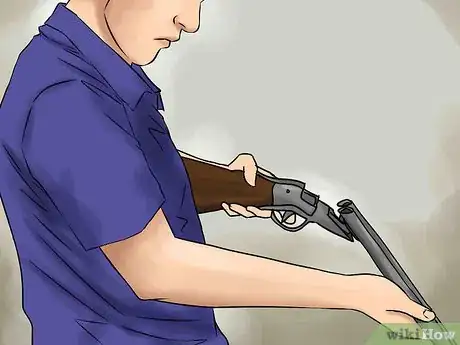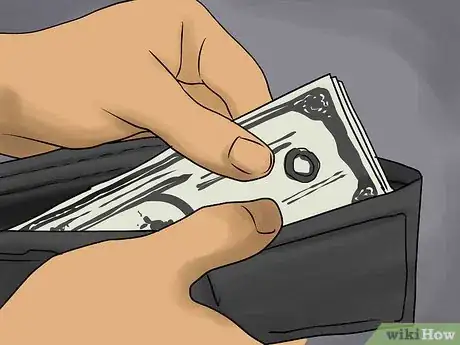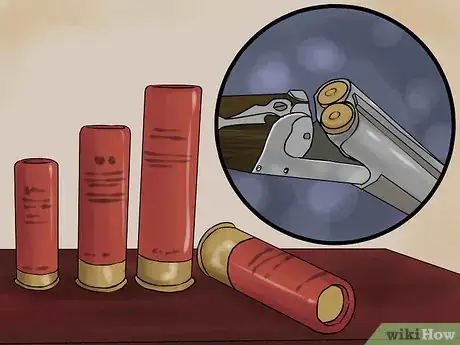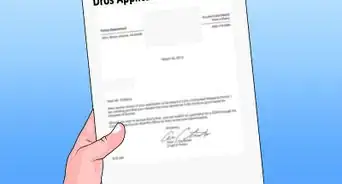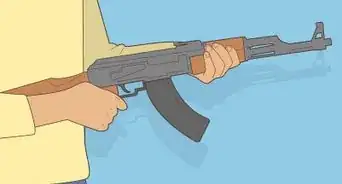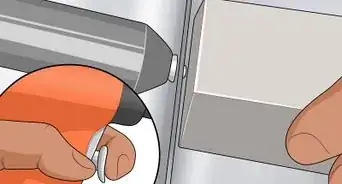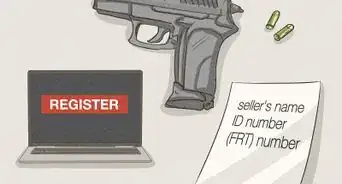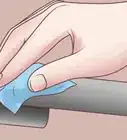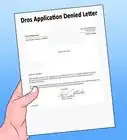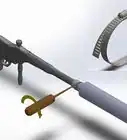wikiHow is a “wiki,” similar to Wikipedia, which means that many of our articles are co-written by multiple authors. To create this article, 29 people, some anonymous, worked to edit and improve it over time.
wikiHow marks an article as reader-approved once it receives enough positive feedback. In this case, 93% of readers who voted found the article helpful, earning it our reader-approved status.
This article has been viewed 289,761 times.
Learn more...
A bewildering variety of shotguns and ammo are available, potentially making it difficult for someone to make a purchase. However, this article will tell you how to choose one!
Background Information on Shotguns
Shotgun Types
- Single shot shotguns are generally the least expensive; their downfall is that they only hold one shell at a time. To fire again, you have to open the breach and insert a new shell, a time consuming activity. Still, they are a functional tool for many tasks.[1]
- Pump-action shotguns are the most common kind. They are known for their low cost (though some models can still get very expensive, they are some of the cheapest common shotguns), and reliability. After every shot you must pump the fore-end (place where you put your left hand) of the gun to eject the spent shell and load another from the magazine tube into the chamber.
- Auto-loader shotguns (also known as "semi-automatic") use a few different types of systems so the only operation you do to fire a round is pull the trigger. Reliability is lowered and using a variety of rounds reduces reliability even more.
- Double barrel shotguns come in two varieties: over-unders (O/U) with one barrel above another, and side-by-sides, in which the barrels are located horizontally. Some people prefer one style, some the other; neither is ultimately better, and both styles are expensive.
For a beginner, a pump action is probably a good place to start since it is very common, cheap, versatile, and reliable.
Shotgun Barrels
-
Barrel length primarily affects the handling capabilities of the shotgun. It also affects the ability to aim the shotgun accurately.[2]
- Longer barrels swing more smoothly and are considered better for predictable targets. Shorter barrels are both easier to maneuver in restricted spaces and are quicker to point; they are considered better for combat or unpredictable birds.
- Longer barrels give you a longer distance from the end of the barrel to your eye, making eye alignment less critical. This makes them more accurate.
- There is a slight increase in muzzle velocity with longer barrels, but it's not enough to worry about. More important is the increased flash and noise when shooting a shotgun with a short barrel.
- A choke is a section at the end of the barrel which slightly constricts the diameter of the muzzle. For shot, it makes the pattern tighter, and travel further while maintaining a dense enough pattern to kill/destroy your target. There are many sizes of chokes, and a couple types of chokes which may be in a barrel.[3]
- The size of the choke changes how wide the spread of the pellets will be. The tighter the choke, generally, the tighter the pattern. Loose patterns allow for greater aiming error, but it also means that your range is more limited.
- The two types of chokes are fixed chokes and screw-in chokes. Fixed chokes are part of the barrel design and cannot be changed or removed (without major work). The screw-in choke means the end of the barrel is threaded (inside the bore) to allow many different sizes of chokes to be easily replaced.
- Slugs and buckshot should not be shot through both tight (improved modified, full, or extra full) fixed chokes or any type of screw-in choke; you are likely to damage the gun.
- Some shotgun barrels are rifled. These are much less versatile than most shotguns, not being able to shoot birdshot, buckshot, or normal slugs, but are very accurate when shooting sabot slugs.
Ammunition
Generally, shotguns are able to shoot two types of ammunition: single large pellets called 'slugs', which make the shotgun act a bit like a rifle, and shells full of smaller pellets called shot, which is useful for hitting small/moving targets.[4]
- Higher shot numbers indicate smaller size shot; #9 shot birdshot is much smaller than #4. This applies to all 'categories' of shot.
- One category of shot is birdshot, used to hunt birds or shoot targets. The most common size, #7 1/2, is about .1" in diameter.
- The other category is buckshot, generally used to hunt large critters such as coyotes or deer. In such a load, pellets as large as .38" are carefully packed into a shotgun shell.
- Shotshells are available in either high-base (AKA high-brass) or low-base loadings. The high-base shells have more powder and are thus more powerful - use them when you need something extra.
- A shotshells come in various lengths. In 12ga, for instance, common lengths are 2.75", 3", and 3.5".
- A shotgun can shoot shells shorter than its chamber (which will be marked on the barrel), but not longer.
- Longer shells have more pellets and more powder... and generate much more recoil. You'll only want to used them when you have to.
- Bore size is also a big consideration as 12-, or even 10-, gauge shotguns can be painful to shoot for some (untrained, sensitive, small, or weak) users. 16, 20, 28 gage, or .410" shotguns are available which have much less kick and thus are easier to handle for such individuals.
- Slugs are useful for hunting large animals at moderate ranges.
- Don't fire slugs through tight chokes.
- Don't shoot slugs through "overbored" barrels.
- Sabot slugs won't perform well in smooth-bore (un-rifled) barrels. Use them in rifled barrels.
- "Rifled" slugs are designed to be used in smooth-bore barrels.
- The patterning board is your best friend for figuring out what ammo your shotgun likes and how various chokes work in it: simply shoot once at a piece of paper and look at the resulting pattern.
Steps
Choosing a Shotgun
-
1Find your dominant eye, generally the same as your dominant hand. This determines if you should purchase a left or right handed shotgun; if your right eye is dominant, buy a right-handed shotgun. Some shotguns can be used by both right and left "eyed" people.[5]
-
2Form a budget; depending upon how much you are willing to spend, you may be able to rule out entire types of shotguns. Generally, you should expect to spend:
- $100 USD on a break-open single shot
- $200-$500 on a pump-action shotgun
- $500-$1000 on a semi-auto shotgun
- $1000+ on a worthwhile double-barreled shotgun
Advertisement -
3Go to a gun store with a large selection of shotguns
-
4Find a shotgun that fits you:[6]
- Pick a spot on the wall
- Close your eyes
- Point the shotgun at that point on the wall
- Open your eyes
- The shotgun should have come to your shoulder easily.
- The stock should not be too short for you. Ask the shopkeeper for advice on this matter.
- You should not have to deflect your head very much from it's natural upright position to place your eye correctly over the barrel; assuming this position should be natural.
- The shotgun should be pointing at the spot on the wall when you open your eyes.
-
5Inspect this shotgun for damage or rust.
-
6If you like the shotgun, it's within your budget, it shoulders naturally, and it's mechanically sound, then you should buy the shotgun!
Choosing Ammunition
-
1Find out what gauge of shotgun you are buying ammo for. The common gauges are 10, 12, 16, 20, 28, and .410. 28 is smaller than 20 which is smaller than 16. The larger the gauge, the smaller in diameter the shell is .410 is an odd exception, just remember it is the smallest.[7]
-
2Find out if your shotgun barrel is rifled. If it is, you can only shoot slugs - preferentially "sabot slugs". If your barrel does not have grooves in it, you can shoot everything, including sabot slugs - though the slugs won't be very accurate.
-
3Decide what you are going to use the ammo for:[8]
- For small animals or clay targets, buy shotshells with small shot ("birdshot", #9 up to, say #4) in them. Not only are they the cheapest shells available, but they are gentler on your shotgun and (generally) your shoulder.
- For larger small animals, such as ducks up to large geese, you should buy shotshells with somewhat larger shot, say #5 up to #2.
- For larger animals, such as coyotes or deer, it is best to use slugs - the largest round available in a shotgun shell.
- Alternatively, you may choose to buy slugs for shooting large animals. Remember, sabot slugs for rifled barrels, "rifled" slugs for smooth barrels.
- To fit a shotgun, Hold the shotgun with your dominant shooting hand with the barrel pointed up, rest the end of the shotgun stock in the crook of your arm, where your elbow is bent, if your trigger finger can reach the trigger comfortably then the gun fits your arm and fits you!
Community Q&A
-
QuestionWhat shells do double barrel shotguns use?
 Community AnswerThe ones compatible with the barrel. For example, a 12-gauge double barrel shotgun uses a 12-gauge shell, but a 20-gauge gun would use a 20-gauge shell.
Community AnswerThe ones compatible with the barrel. For example, a 12-gauge double barrel shotgun uses a 12-gauge shell, but a 20-gauge gun would use a 20-gauge shell. -
QuestionCan I fire 3 1/2 inch shells in a single shotgun?
 Crystal DubinCommunity AnswerIt depends on the size that is written on the barrel of your shotgun. It will be stamped. If you are unsure how to find it, rub your fingers along the barrel, and when you come across a rough touch, that is where you will find the size.
Crystal DubinCommunity AnswerIt depends on the size that is written on the barrel of your shotgun. It will be stamped. If you are unsure how to find it, rub your fingers along the barrel, and when you come across a rough touch, that is where you will find the size. -
QuestionWhat's the best gauge and gun type for doves?
 RajajeyamCommunity AnswerModified is probably best overall for doves. It really depends on your range, though. I actually shoot a full choke for all bird hunting to give me additional range. You just have to let doves get 30 yards or so before you shoot if you use a full choke.
RajajeyamCommunity AnswerModified is probably best overall for doves. It really depends on your range, though. I actually shoot a full choke for all bird hunting to give me additional range. You just have to let doves get 30 yards or so before you shoot if you use a full choke.
Warnings
- Respect the shopkeeper's property: ask permission to shoulder the shotgun in the store, to rack the slide/bolt, and such actions.⧼thumbs_response⧽
- Don't shoot buckshot or slugs through a tight choke.⧼thumbs_response⧽
- Make sure you handle the shotgun safely in the store. You don't want to be unsafe or upset other people!⧼thumbs_response⧽
References
- ↑ https://www.artofmanliness.com/articles/a-beginners-guide-to-the-shotgun/
- ↑ https://www.outdoorlife.com/choose-best-shotgun-barrel-length/
- ↑ https://www.fieldandstream.com/how-to-choose-right-shotgun-choke/
- ↑ https://www.artofmanliness.com/articles/a-beginners-guide-to-the-shotgun/
- ↑ https://www.hunter-ed.com/montana/studyGuide/Your-Dominant-Eye/201027_700048239/
- ↑ https://www.shootinguk.co.uk/shooting/start-shooting/buying-a-first-shotgun-54935
- ↑ https://www.range365.com/how-choose-right-shotgun/
- ↑ https://www.range365.com/how-choose-right-shotgun/


